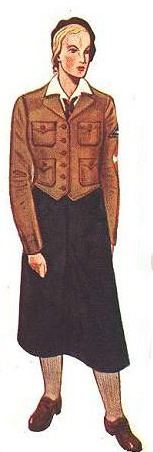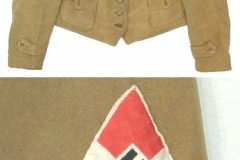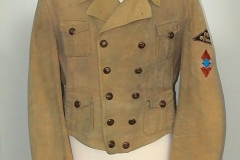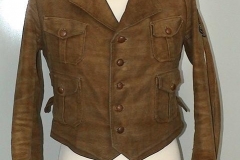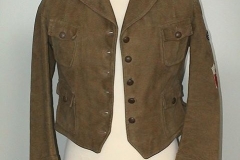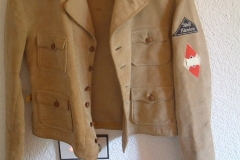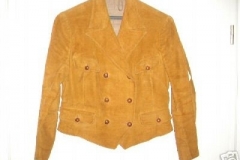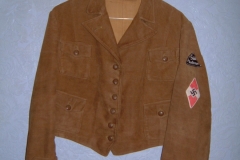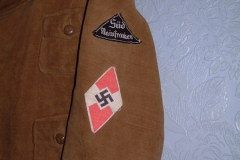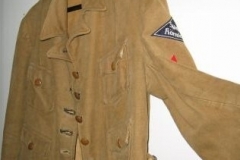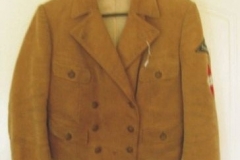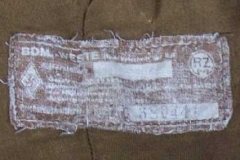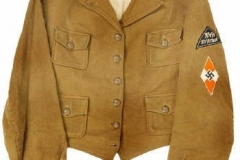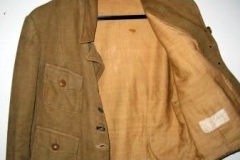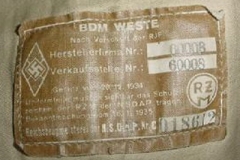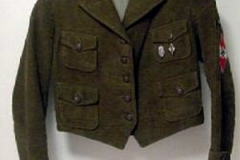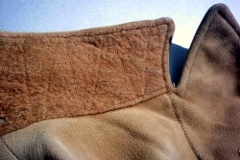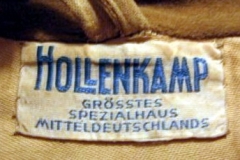Introduction
Just like the boys and young men of the male Hitler Youth, the girls and young women of the Jungmaedel and the League of German Girls also had service uniforms that they wore to all official BDM function. The basic uniform, which we will consider the “summer” uniform for the purposes of this website, consisted of a dark blue skirt, a white blouse, and a black neckerchief that was held together with a leather slide. Please check the “summer uniform” page for more information about that basic uniform. This “winter uniform” section mainly deals with the additional uniform items that were worn in colder temperatures such as jackets, overcoats, hats, and, of course, the ski uniform.
The service uniform was to be worn to any functions the League of German Girls participated in, such as parades and events, but also to all meetings of the League, as well as on trips and outings. Wearing your uniform outside of special occasions was originally not allowed, but it soon became commonplace for members of the BDM to wear their uniforms to school. Some teachers who were party members often preferred girls who were active in the BDM over their other students and gave them better grades, while they admonished girls who weren’t members or were not very active in their service.
Because parents had to purchase the uniform for their daughters, it was not uncommon that a girl joined, but her parents either refused to or could not afford to buy her the complete uniform. Especially the climbing jacket was not always well-received by parents and many former members recounted that they never owned one and wore a trachten sweater or their regular “civilian” jackets instead.
In many instances where parents could not afford to purchase the uniform, they were home-made from approved patterns sold at clothing stores in the towns, such as ABC Schnitt or Lutterloh. Or else they were substituted by using clothing that “looked right”, such as a regular white blouse and blue skirt. This was especially common among younger members in the Jungmaedel because it was expensive to buy new uniforms each time a girl grew out of them. If a family had several daughters, uniforms were often handed down to younger siblings. This accounts for a lot of variations in styles, colors, and fit among the BDM uniforms that we see in photos and especially on the collector’s market.
The Climbing Jacket
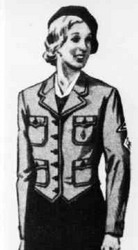 The so-called Kletterjacke, or climbing jacket, is probably the single most recognized uniform piece of the League of German Girls. It was designed to be worn with the BDM uniform on colder days of the year such as spring, and fall, and in many instances it was also worn during deep winter or with civilian clothing if the girl didn’t own another warm jacket that she could wear to school or to go out on cooler days.
The so-called Kletterjacke, or climbing jacket, is probably the single most recognized uniform piece of the League of German Girls. It was designed to be worn with the BDM uniform on colder days of the year such as spring, and fall, and in many instances it was also worn during deep winter or with civilian clothing if the girl didn’t own another warm jacket that she could wear to school or to go out on cooler days.
The climbing jacket was a very stylish waist-length jacket that was cut a bit shorter in the back than the front to create a slimming silhouette for the wearer, similar to the cut of the military uniforms of that time period. It was made from fawn color suedette, or faux velour, fabric, and was generally lined with a lighter brown rayon or cotton fabric on the inside. Variations in color and materials were very common between the different manufacturers and between different bales of material. Variations are especially common in the material of the liner, which range from light tan cotton to rayon to very dark browns, greens, or even purples. Jackets manufactured during wartime were most often made with rayon liners since rayon was domestically produced whereas cotton had to be imported.
The back of the jacket had two small take-up tabs with a small metal buckle, but plenty of variations without this buckle are seen. The front of the jacket had four small patch pockets, and two different types of pockets are commonly seen – plain ones and ones with a center pleat. At first sight, the buttons on the climbing jacket appear to be woven leather (a popular style at the time), but upon closer inspection they are actually molded bakelite buttons with the letters BDM and JM embossed on them.
The lozenge-shaped Hitler Youth insignia as well as the Gau triangle patch were worn on the left sleeve of the jacket. One should note, however, that because patches had to be purchased by the girls or their parents, we frequently see jackets that only have the triangle, only have the HJ patch, or have no insignia on them whatsoever. This was not uncommon and if you, as a collector, find a jacket without insignia, it is possible that it never had them at all.
Because sometimes a girl’s family could not afford to purchase the jacket, or the parents did not approve of it and therefore did not want to purchase it, not all members of the League of German Girls owned them. We also see a number of homemade variations and different variations made by manufacturer – some of those are made of corduroy, others have additional pockets on the inside, or a double row of buttons on the outside. Occasionally, variations with only two pockets on the outside are also seen.
The large number of photos below, many of which were either submitted by supporters of this website or taken from online auctions, will give the researcher and collector and idea of the many different styles, cut, and color variations that are commonly seen in these jackets, as well as some of the insignia and button types used, and even different types of labels found on issue jackets.
Please note that not all BDM uniform jackets closed the “female” way, to the left, some closed to the right. You can see both styles worn in the extensive photo galleries on this website.
The Berchtesgaden Jacket
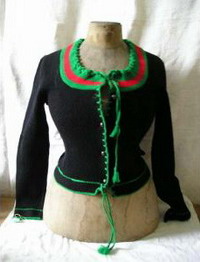 One of the less frequently documented, although not that uncommonly photographed, jackets of the League of German Girls was the black, red and green Berchtesgaden jacket. This particular style was traditional to the Berchtesgaden region after which it is named and can still found virtually unchanged in local trachten stores of that region of Germany.
One of the less frequently documented, although not that uncommonly photographed, jackets of the League of German Girls was the black, red and green Berchtesgaden jacket. This particular style was traditional to the Berchtesgaden region after which it is named and can still found virtually unchanged in local trachten stores of that region of Germany.
The Berchtesgaden jacket was made of knit black wool with a stripe of green trim at the bottom, and three wide stripes of green and red trim along the collar. It had small silver buttons, and both the waist and collar of the jacket were tied with twisted green wool cords. This jacket style is commonly seen in photos during colder days worn over the white blouse and either in lieu of, or underneath the climbing jacket. A similar style where the jacket is white instead of black is seen in a few photos, and trachten jackets of different styles are also sometimes worn, although they were by far not as common as the Berchtesgaden style.
The researcher and collector should note that the detailed photo of the Berchtesgaden jacket below came from a display at the German Museum in Munich, Germany. Even though the jacket on display on the dress form has a Hitler Youth armband attached to it, as well as a pin to hold the leadership lanyard, there are no period photographs of any kind showing it worn in this fashion. As a matter of fact, there isn’t a single photo in the many pictures on this website showing members of the League of German Girls wearing any kind of Hitler Youth armband. I believe that the display of this dress form is based more on some rather fanciful ideas of the museum staff than actual historical research.
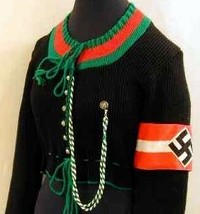
The Beret
 For winter, the League of German Girls had a black wool beret that was meant to be worn with the uniform. A regulation- style beret that was made up of six parts existed, but many photos show girls wearing berets that are of one- or three piece construction similar to French berets of the same time period.
For winter, the League of German Girls had a black wool beret that was meant to be worn with the uniform. A regulation- style beret that was made up of six parts existed, but many photos show girls wearing berets that are of one- or three piece construction similar to French berets of the same time period.
Although the type and often the size of the beret varied, they were black or dark blue in color and worn pulled down over one ear, as can be seen in the photo on the right.
The beret is most commonly seen without any kind of insignia, although shortly prior to the introduction of the new leaders’ uniforms (and with them, lovely new hats), a small insignia with an eagle existed, but was hardly ever worn. Both the beret and the insignia were not very popular with League of German Girls members – as the lack of both in the vast majority photos attributes to.
The Overcoat
 The League of German Girls had a dark brown greatcoat for wear during the winter months, which was apparently a very unpopular piece of clothing, or at least not a piece of clothing that a lot of girls purchased, since it is almost non-existent in period photographs.
The League of German Girls had a dark brown greatcoat for wear during the winter months, which was apparently a very unpopular piece of clothing, or at least not a piece of clothing that a lot of girls purchased, since it is almost non-existent in period photographs.
The drawing on the right, from a period illustration about the League’s uniforms, appears to be the main source about the greatcoat cited in most books about the League of German Girls, which is not surprising considering the lack of actual photographs.
David Littlejohn writes in his book “The Hitler Youth”: An interesting feature of the League of German Girls greatcoat is that instead of the Gau triangle, a cufftitle was worn on the left lower arm (the positioning being described as “three fingers width above the end of the sleeve”) on which was the name of the Obergau in white lettering on blue (for BDM) or white lettering on brown (for JM).”
The two images below show BDM girls dressed uniformly in a brown wool overcoat which varies slightly from the one in the drawing on the right in that it has a belt. Other than the belt, the overcoat appears to be identical to the one in the illustration.
The girls pictured in the photographs are taking part in the Landdienst der Hitlerjugend, as their cuff-titles state, and the images were taken in 1939, just before Christmas. The photos are from the webmaster’s collection. Click to enlarge.
no images were found



